The iPhone 6 Review
by Joshua Ho, Brandon Chester, Chris Heinonen & Ryan Smith on September 30, 2014 8:01 AM EST- Posted in
- Smartphones
- Apple
- Mobile
- iPhone 6
Camera
In order to really understand the camera of the iPhone 6, we have to first talk about the components that make up the camera system. While we don’t know the exact model number of either the iPhone 5s or iPhone 6 sensors, we do know that both the front and rear cameras are made by Sony. For the most part, it seems that the optical system is largely unchanged from the iPhone 5s to iPhone 6. The focal length and aperture are identical, and both have five plastic lenses. On the sensor side there are some obvious differences such as the addition of phase detection pixels. However, it’s otherwise difficult to say if anything else has changed in this area. There’s also a new ISP on the SoC, which serves to enable features like 240FPS slow motion video.
Based on what we know about the camera, the one highlight feature seems to be PDAF. While we’ve seen it before in phones like the Galaxy S5, we’ve never really talked about how it works. In short, microlenses on the sensor refract incoming light onto the AF detector in pairs, as seen in the photo below. Once this is done, the image produced by each AF sensor is compared for similarities. By finding these similarities, the ISP can know whether the lens is focused at a point short, long, or on the intended subject and command lens movement to focus on the intended subject. In case 1 in the photo, we see a situation where the camera is focused short, so the lens must move in order to properly focus on the subject, which is case 2. Case 3 and 4 show increasingly extreme cases of focusing too far to focus on the subject.
Source: Wikipedia
The real question is how it works. While we don't have an ideal test for auto focus and capture latency, we can at least get an idea for best case latency by looking at latency for both cases when viewing a well lit ISO chart, which has extremely high contrast and strong lighting so PDAF should be able to operate.

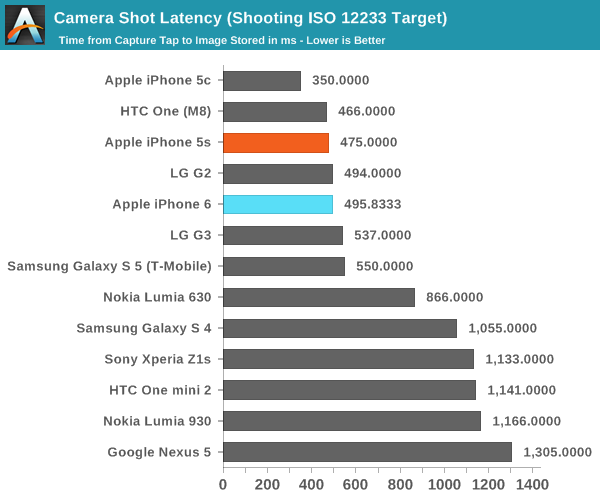
As you can see, it seems that capture latency is mostly unchanged when comparing the two phones but focus latency is dramatically improved in the best case, which is around 200 milliseconds. While the Galaxy S5 does have PDAF, in my experience it was hard to tell if it was any faster than a mostly contrast-based solution like the One M8. With the iPhone 6 the use of PDAF is immediately obvious because in well lit conditions the camera always snaps to focus without ever waiting for the ISP to detect an out of focus condition and run an AF scan. Oddly enough, in all of the manual camera applications that I've tried none of them seem to be able to use continuous auto focus in the preview, which suggests that this isn't exposed in the camera API.
On the UI side, the new camera application isn't a significant departure from what we're used to in iOS but there is one odd UI inconsistency present in the new UI, as in the slow motion video mode tapping the fps option will toggle between 120 and 240 fps but the same isn't true of 1080p60 video, which has to be toggled through the settings application instead of within the camera application.
Otherwise, I'm generally happy with the camera, especially with the new exposure biasing mode which does away with the need to try and get a specific exposure by locking exposure and reframing to get the right photo. While this certainly isn't a new feature the ease of use makes for a better implementation than most. Generally, exposure biasing is hidden in the settings menu so it's a setting that is only selected once and never again. However, Apple's solution will always default to 0 EV and allow for biasing by swiping up to increase exposure and down to reduce it, which means that this solution is fast and easy to do when taking a photo.
Overall, I don't have significant complaints with the camera UI or the general shooting experience. While I'm still looking for an ideal manual camera application I find Apple's mostly all auto solution to be more than sufficient. Of course, the shooting experience alone isn't enough to evaluate a camera so we'll look at image quality next.
Still Image Performance
While I'm still not quite happy with the state of our camera testing procedures, our current tests can generally give a good relative comparison, so the data we're looking at can still be used to draw some conclusions about the camera being tested. One of the first tests that we'll look at is the ISO chart, which uses increasingly tight line spacing to determine what the maximum resolution of the camera is.
In this test, the iPhone 6 does reasonably well, showing low aliasing until around the 16 or 17 mark, which seems to be about the same as the iPhone 5s. In general, this is one area where the iPhone falls short of the competition, which generally tends towards 1.1 micron pixels and sensor sizes larger than a third of an inch. However, it's definitely a great more detail than what we see on the four megapixel sensor of the One (M7) or One (M8). Given the sensor size constraints that Apple seems to be working with this is a respectable showing.
The next scene we'll look at is a daytime landscape shot. For the most part the iPhone 6 does admirably, as noise is well suppressed without noticeable oil painting effects that arise from when noise suppression is too strong and blurs out detail. Dynamic range is also generally quite good as shadowed areas have noticeable detail in this scene. In comparison to the iPhone 5s, while it's relatively hard to see any real differences in detail the noise in areas like the sky and in shadows are noticeably reduced without an obvious decrease in detail.
Following along the lines of the landscape shot, I also set up a lightbox scene with a few objects of varying contrasting textures, text, and feature size to get a good idea of what the limitations of the camera are. In this test scene, we actually see some level of improvement in detail when comparing the iPhone 5s to the iPhone 6. This is most obvious when looking closely at the texture of the metal bell. When compared to the Galaxy S5 LTE-A the iPhone 6 does fall behind a bit due to lower resolution and a mildly wider field of view.
For the next scene, I used the light box and standardized dim lighting in order to provide an example of camera performance between extremely bright and dark scenes. Here, it's relatively difficult to see a difference between the various phones, although with some cameras we're already starting to see a significant amount of detail blurred away in areas like the bell which has a great deal of low contrast detail. There's not too much difference here when comparing the iPhone 6 and 5s, although the 6 does have noticeably lower contrast in these situations.
At the extremes of low light photos, we definitely see a notable improvement in the iPhone 6, which can be attributed to the lower ISO. However, for better or worse we don't see a significant difference in exposure which suggests that this sensor likely has improved sensitivity despite identical pixel size. While we have no way of knowing the exact sensor, it's logical to conclude that the iPhone 6 is using a CMOS sensor process similar to the IMX240 in the GS5 LTE-A at a larger pixel pitch for better sensitivity. What's really incredible about this test photo is that the iPhone 6 manages to deliver an output close to what we see in the iPhone 6 Plus at four times the ISO/sensor gain.
The next two test cases are less about the camera itself and more about how well the OEM has integrated software and hardware. The first test we'll go over is the LED flash test in the lightbox scene that was previously used. While LED flash is generally a rather poor solution for low light photos, it's still important to test as there are some situations where it's absolutely necessary. In this case, Apple has done a great job of selecting an appropriate brightness level to evenly illuminate the scene and provided enough light to keep noise to a minimum, but for some reason there's a pink/red tint to the entire scene. This is one area where the iPhone 5s seems to provide more even color rendering as there is no such tint.
In the HDR test, there's a noticeable improvement in detail and dynamic range from the iPhone 5s to the iPhone 6. Key areas of note include the Media Link HD box, which has noticeably clearer text and there's also significantly more detail on the bell. Judging by the general improvements to detail in closer shots, it may be that these effects are either too subtle to see in landscapes or simply smudged away by noise reduction. There's relatively little to criticize here, as Apple seems to be effectively merging multiple exposures without obvious halos or similar effects that make HDR almost impossible to use in most circumstances.
Overall, the iPhone 6's camera represents a solid improvement over the previous generation, with less noise, more detail in some circumstances, better HDR, and improved low light performance. While it isn't a huge leap ahead, it's definitely more than one might expect. The improvements are subtle though, as there are no fundamental changes to the optics or sensor.








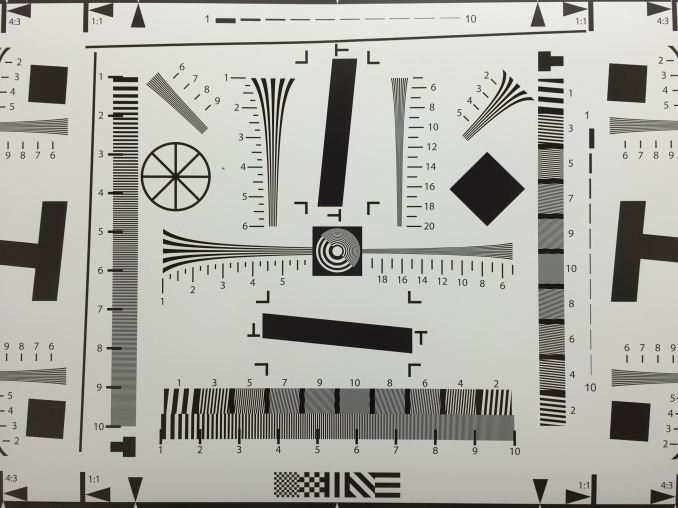






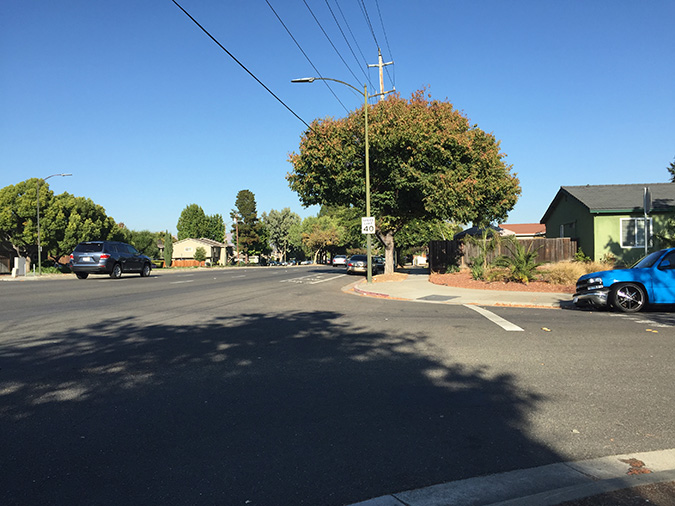






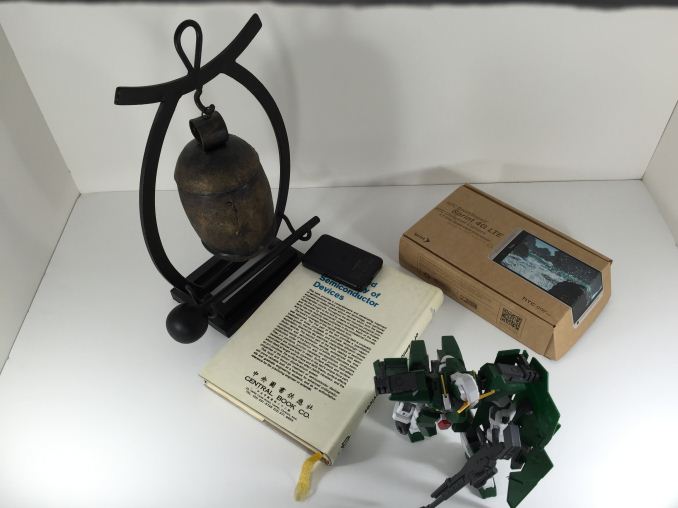






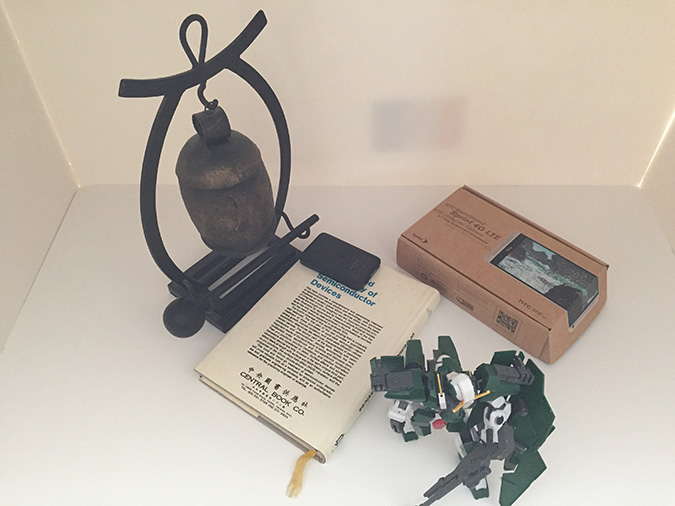






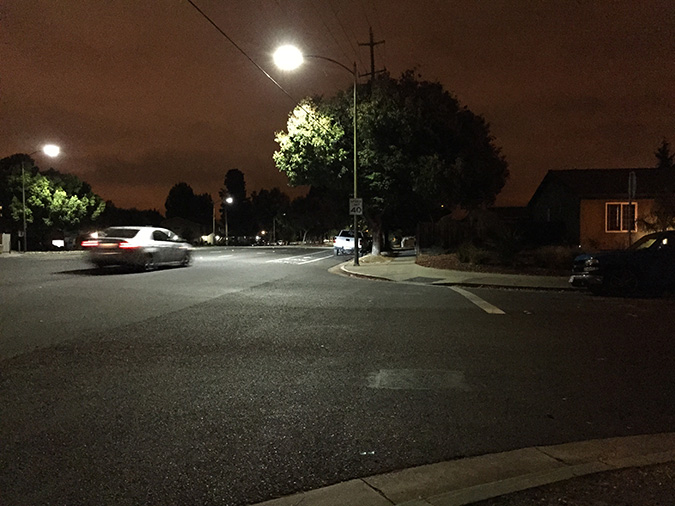









_thumb.jpg)



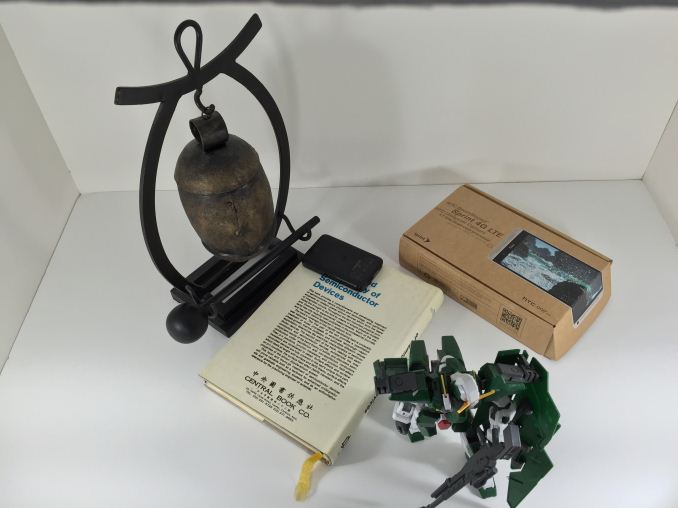








531 Comments
View All Comments
Caliko - Tuesday, October 6, 2015 - link
A good phone runs its own OS.You and that moron don't understand HD so your obsession is invalid.
echtogammut - Tuesday, September 30, 2014 - link
He isn't wrong about anything he said, but I just can't imagine getting worked up enough to say it. As a current Apple user/developer, I have every Apple product. I like their stuff, but I can't say I am obsessed about it. I also have a lot of the competing products, so I am constantly toying with all of them. When my current iPhone breaks, I will probably replace it with a Sony Xperia Z3 compact, because it looks like a perfect phone for me. I am not interested in a bigger phone and I would like something that is waterproof, because I run or ride a rain, sleet or shine. I personally think Apple is falling behind in the world of business and multi-use devices. I am seeing a lot of customers whom I developed business apps for iOS coming back and wanting to move to Microsoft or Android platforms because the devices are more powerful and offer more robust features.GerryS - Wednesday, October 1, 2014 - link
I agree. He makes some good points, though most of them are seriously overstated. For most users (yes, nearly everyone in my experience) a "pretty dang good" display is about as good as we can be bothered to look for. I actually like the display on my iPhone 4s. I've never had a complaint, except that it is small, so I got an iPad.See, I don't actually like it that Apple went for big phones. I carry my phone in my pants pocket. The 6 might be about the limit of the size phone I want. If I could get an updated 4s with the processor and other basic features of the 6, that's what I'd buy.
So, for most consumers, we want something that works. I had 4 Android phones before Verizon got the iPhone. I liked them pretty well, but they kept breaking. I went to Apple for dependability, and have not been disappointed. I've only had a couple of problems (even with my jailbreaks), and they've always been easy to fix.
I do like it when Apple leads the way, but it would be silly to expect them to have all of the advances. So many people compare the iPhones to Android phones, listing all of the things that came out first or "better" on Android phones. They seem to forget that there are dozens of companies making Android phones. The best of them have only one or tow innovations at a time - about the same as Apple manages. Apple continues to be one of the leaders, as long as you compare them to one company at a time.
If you want the universe of advances coming from Android manufacturers, then go buy an Android. We really won't hold it against you. For me, I like my iPhone and iPad. My wife has Android (at my recommendation) because we could get some features that were important to her.
Actius - Wednesday, October 1, 2014 - link
Lol, he is wrong about his engine analogy! Seriously, none of that makes any sense. Haha, and what's a "V8 compressor"? My goodness...people shouldn't talk about things they really don't know. Just reading that was cringe worthy.sigmatau - Thursday, October 2, 2014 - link
I'm going to guess you are not so dense as to be picking at the spelling but instead don't know what is a v8 Kompressor. Not only one of the best engines that Mercedes made, but also award winning by 3rd parties.techconc - Thursday, October 2, 2014 - link
Actually, he is either wrong or extremely misguided in almost everything he's said. Feel free to pick your argument of choice. He starts off by saying how the iPhone 6 launch was disastrous. As compared to what? What other vendor will sell 10 million devices on a launch weekend? Even for Apple, it broke their own previous records. I'm genuinely grateful for people that prove they're an idiot right up front. It lets me know I can either skip the rest of the post or read on for purely amusement purposes.That's just the conceptual part of the post. His technical observations were equally misguided. Especially with regard to screen quality, etc. Clearly he didn't bother reading the Anandtech review he's commenting on.
shm224 - Thursday, October 2, 2014 - link
@techconc: Sure, what other products you know starts to bend, or totally crap out after the first buggy update, or even have features withdrawn due to more bugs all within the first week of release?akdj - Friday, October 3, 2014 - link
Really? You're still convinced the iPhone (6 OR 6+) actually and easily 'bends' in the first week? Buggy update? The one available for about two hours that few downloaded and within ten hours of pulling it a fixed update was released? Features withdrawn? I'm intrigued ..as an owner and realist like techconc, the person you responded to... I've GOT to know!I'm patiently awaiting my pair of 6+s for my wife and I. We just returned from the mall and the Apple Store specifically playing for almost two hours with them. I built a two minute movie and. Rendered in 1080p in about 35/40 seconds, air dropped to myself. Un. Believable phone. It's. Amazing
We ordered launch day through our business representative. Lol. Silly me. Ship date estimate is pretty specific, actually a bit ambiguous with the latest update. 11/2-11/28/14:-)
Oh well. Plenty of time to allow developers to continue updating their apps.
Between my Air, rMBP 15" and the iPhone 5s /6+, my business of 27 years has been revolutionized. Literally, over the past half decade, as a pilot and sound/video producer...weight savings alone are enough to double our profits. And ½ our setup snd break down times. Even my 'flight bag' of nearly fifty pounds isn't necessary. With three retina minis in the cockpit for redundancy, the 'paper' is still there, but unnecessary any more for updates to plates and Jep charts, winds aloft and weather/traffic ...even diversion airports, filing my flight plan and telling me how thirsty she is! Fuel calculated, with a GPS dongle a tenth the price and 100 fold quicker to lock n track than avionics just a half decade ago provide incredible accuracy. ADSB and TCAS (3D terrain, weather and other traffic/with their specific info; altitude, speed, heading, and Xspnder --- TCAS, a warning system that 'tells you what to do' in conjunction with other planes fitted with the system including all commercial traffic and many GA pilots with ILS certifications ...Alaska can get nasty quick and having to 'duck down' these two systems alone are incredible and 'reasonably priced' advancements!).
I'm not sure there's a place in my life iOS has t changed. As a father, business owner and operator, little league and wrestling coach, and pilot...each iteration has improved signficantly enough in 'most situations' to justify yearly updates for me. iPhones hold their value. Until the 4s, AT&T was generous and 'allowed' a 12 month subsidized update. With the business I also provide 17 full time employee iPhones so we've been lucky enough to 'recoup' some of the money spent each update
I just sold an employee's iPhone 5, 32GB AT&T with a cracked screen, scratched to hell and working perfectly. With excellent battery health and perfect camera lens (only scratch-less area of the phone!) for $235 to a local repair guy. He saw me in the mall with the Gazelle box (more than a hundred bucks less) on my way to the USPS. Asked what I was sending. Told him. Showed him a 'picture' or seven before I unboxed it, but he was adamant ...he was able to shine it up with his pieces n parts for $45 or less! Told me it would cost a customer about $210 to do the work but parts were 20% the cost ...labor and time is the price. From there he was confident he could sell it for $325-350 at his kiosk within 24 hours.
My son has had his fifth generation iPod touch for two years. He's nine. No scratches. No scuffs. Clean a booger or twelve off once a week but other than that, it's completely 'perfect'. These iPhones are built damn near the same. Sleek, thin and well balanced ...no bugs, incredibly quick and unless you're a dumbass and put your $800 pocket computer in your rear pocket of your jeans and SIT on it, you're an idiot ...and you've got to be SIGNIFICANTLY overweight AND hit the precise angle in order to 'mash' 100 pounds of pressure to a 'single point'/torque.
Can you bend em? Yep. It's been proven and EVERY piece of proof we've seen visually demonstrates the incredible amount of force necessary and in such a way not indicative of daily use or situations a consumer would find themselves in 99.9% of the time.
Don't. Be. Silly. I respond not only to you but to all those talking like you. Until you've used one. Felt one. Actually spent time with it, it's difficult to understand.
These are absolute and unequivably the BEST two phones on the maket at this time. With the best and most abundant apps/software optimized to its specs. Support to back it up. And resale value when Ya get bored and ready for a new one. You'll recover your 'down payment' plus fifty percent in many cases ...if you take care of it. Seemingly, they're even more valuable than a same year flagship Samsung Note 2, as I wasn't able to get more than $125 for that joke. Note 3 got it right. But it took twice the cores, clocked at twice the speed with three times the memory ( ⅔ to ¾ of which is in use even without an app running! I've got one though and don't take me wrong, I love it) to get 'close' to the GUI fluency of the iPhone & iOS
That's. SAD. That's. Buggy. I'd much rather have a phone that bends with a hundred pounds of torque in a certain and specific area than I would gambling I'll get an update, deal with carriers and OEM bloat and shitty aesthetics and design. Lack of support or resale, lack of apps and software ...& the apps and software in parity are incredibly more enjoyable and stable on iOS. I like my Note for browsing and the SPen. I think an active digitizer would put the six plus over the top but as it is, it's perfect.
Indeed, I'll continue using (& owning) my N3. But I'm not the least bit compelled with the '4' and its 2540 display. While I'm sure there's noticeable and 'obvious' benefits to having 550/600+ PPI ...I'll warn ya when you're 38-42, speaking from experience...you'll need 'cheaters';) ...like our ears, our eyes deteriorate as well ...the elasticity of our lens and ability to change and 'maintain' up close focus just ...goes away! Hence the incredible benefits I've found witg the HiDPI display technology. 3D? Good riddance! It was a joy to see 4k/Ultra HD and even examples of 5/6 & 8K motion display AND capture gear instead of dumbass glasses and crappy off center viewing with limited content.
Apple lead the way and destroyed multi billion dollar monsters in the industry with the iPhone. They then changed consumer display technology's availability. HiDPI and increased resolution is awesome. But to a certain point. Your 1080p 65" LED LCD IPS or AMOLED TV in the living room at 10-12 feet or typical viewing distances is around 100ppi. Quadrupling the resolution (4k) while not exactly linear, will amount to approximately an increase of 100%. To 200ppi. Not four foukd as you may think.
The 'new' ipad(3)/4 -- iPhone 4 -- the rMBPs --- ALL Game Changing home runs. Putting a certain 'joy' back into 'work' again. With SUCH an accurate palate and the ability of OS X'es scaling of the UI (& third party apps the same ...utilizing pixel for pixel when necessary or quadrupling for the GUI simultaneously and without 'glitches' or latency is a marvel in engineering. Coupled with the IrisPro 5200/750m and PCIe SSD at a TB with read and write speeds exceeding a Gb/s, Thunderbolt 2 and its 'one' cable capabilities and abilities to run multiple 4K displays ...shoot man. Seems like yesterday I was hunting the wax pencils and cutting my fingers slicing tape ...now it's immediate and fast as hell in a four pound package at a dozen times the resolution.
Times are good if you're an Apple user. And thats JUST the hardware!
OS X and iOS's march to marriage is incredible. Continuity and Handoff. Air drop between iOS and OS X, as well ...the aggregation and integration between the devices you're using is revolutionary. Period. Only Windows has the power and support vertically and horizontally to compete with what Apple's doing. Vertical & Horizontal backbones.
No one that needs to 'work' is buying a Chromebook
J
elajt_1 - Friday, October 3, 2014 - link
This must've been the longest and weirdest Iphone ad I've ever read. ;-)techconc - Monday, October 6, 2014 - link
@shm224 - I now know several people with iPhone 6 and 6+ devices that keep them in their pockets. They all seem to agree that there is no merit to this "bend gate" nonsense. While nobody doubts that these phones can bend under a certain amount of pressure (90 lbs. according to Consumer Reports), from a practical matter, it's a non-issue. Further, I find it rather interesting that phones such as the HTC One which bend under significantly less pressure (70 lbs.) don't receive the same sort of media attention.As for the 8.0.1 update, yup, Apple screwed that up. Fortunately, for Apple, the update was pulled after about an hour. It's also fortunate that in only affected some phones and only for the over the air update as opposed to the iTunes update. To your point, no, this typically isn't an issue for other phones... then again, neither are regular updates.